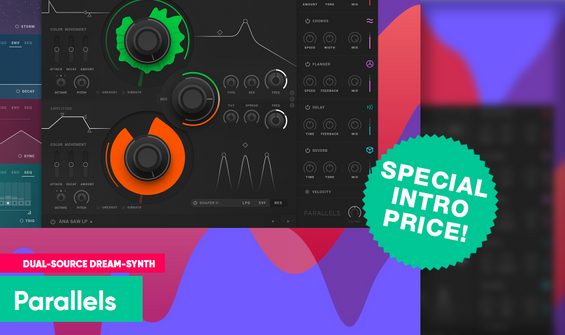Introductory Price on Softube's Brand New Parallels Software Synth
15th Mar 2019
From now until the 12th April get Introductory Pricing on Softube Parallels Dual-Source Dream Synth.
In Stockholm, Sweden, there’s a synth emporium like no other – a store with such vibrancy, such range, such color, that you’d need a dozen eyes and ears to take it all in. And the guy who runs it is no ordinary guy. He’s special, in all the best ways. His imagination fizzes and crackles with delight at the sounds of a million billion sparkling circuit boards.
Out of this hot-bed, this toy-box, this fantasy-factory, Parallels was born; an instrument with not one but two sound sources, each running painstakingly recorded and exquisitely calibrated multi-waveforms from every dream-machine must-have synth you could ever want, and sculpting the resulting sounds with the highest-quality Softube filters, modulators, and effects
Elegant Workflow, Superb Layout & Visual Feedback
There are many possible approaches to take in creating a brand new instrument. Parallels focuses on two main things. First, it should always sound fantastic, with a minimum of fuss. And second, it should inspire the artist with elegant workflow, superb layout and visual feedback, and a sense of endless possibility.

Pre-Recorded Multi-Waveforms
A huge part of the first point is taken care of by the source material. Almost a hundred high-quality pre-recorded multi-waveforms live at the heart of Parallels. These come from classic synths, digital and analog, hard-wired and modular, FM and phys mod, and from environmental and combined sources too. Even some super-rare and unreleased pieces are represented.
Each waveform has a progression of some kind in its 15 second duration – a filter sweep, or a pitch diffusion for example – and playback can start from any point of the artist’s choosing, providing almost infinite sounds-per-sound, even at the source. The playback method can be described as wavescanning, with pre-calibrated loop lengths per source for the best possible sonic outcome. The artist can choose how far the playhead will move through the source scene, and at what rate, before returning to its start point and settling into its sustain loop. All this with up to fourteen voices at once.

Analog-Modeled Filters
Even just one of these source sections would be an intriguing instrument on its own. Parallels has two; independent and blendable in parallel; and much more besides.
Each source can pass through its own shaper section, for example, with a choice of three analog-modeled filter types; a state-variable filter (low, high, or band-pass), a vactrol-style low pass gate, or a triad of resonant peaks.
And what about the four ‘mod pods’ on the left! Each one can be filled by one of five modulator types (LFO, random, Euclidian sequencer, step sequencer, or envelope) and can modulate almost any parameter in the instrument, even pairing up to co-modulate single parameters in a blend amount selected by the artist. Apart from being utterly beautiful, the five modulation source options are versatile and intuitive, bringing all sorts of possibilities to the rest of the instrument.






